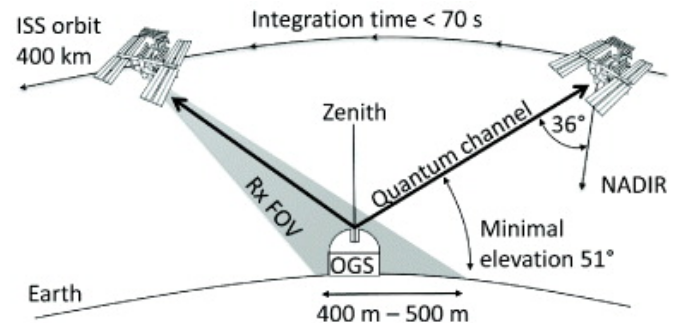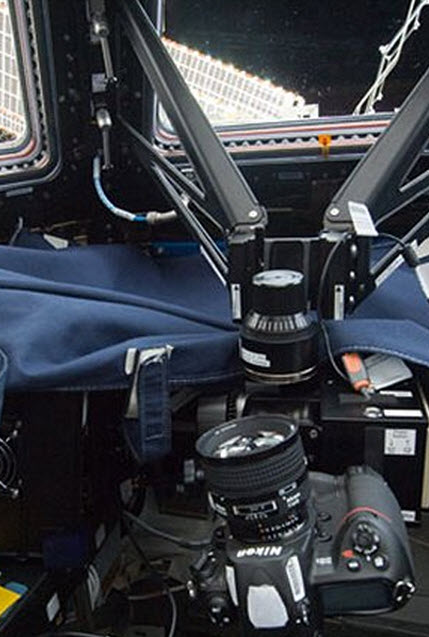‘Spooky action at a distance’ to be tested aboard the ISS
April 11, 2013

International Space Station (credit: NASA)
Researchers at the Institute for Quantum Optics and Quantum Information in Austria and the European Space Agency have proposed using the International Space Station (ISS) to test the limits of “spooky action at a distance” (remote quantum entanglement) and potentially help to develop the first global quantum communication network.
Albert Einstein famously described quantum entanglement as “spooky action at distance”; however, up until now, experiments that examine this peculiar aspect of physics have been limited to relatively short distances on Earth.

The orbital pass of the ISS over an optical ground station could be used for quantum communication (credit: T Scheidl/New Journal of Physics)
The experiment would be the “first-ever quantum optics experiments in space,” the researchers say.
Their plans include a “Bell experiment” to test the theoretical contradiction between the predictions of quantum mechanics and classical physics, and a quantum key distribution experiment, using the ISS as a relay point to send a secret encryption key across much larger distances than have already been achieved using optical fibers on Earth.
Their calculations show that “major experimental goals” could already be achieved with only a few overhead passes of the ISS, with each of the experiments lasting less than 70 seconds on each pass.
“During a few months a year, the ISS passes five to six times in a row in the correct orientation for us to do our experiments. We envision setting up the experiment for a whole week and therefore having more than enough links to the ISS available,” said co-author of the study Professor Rupert Ursin from the Austrian Academy of Sciences.
Equipment: photo detection module and existing ISS camera

ESA’s NightPod camera hardware in the Cupola Module of the ISS (credit: NASA)
The only equipment needed aboard the ISS would be a photon detection module, which could be sent to the ISS and attached to an already existing motorized commercial photographer’s lens (Nikon 400 mm), which sits, always facing the ground, in a 70 cm window in the Cupola Module.
For the Bell experiment, a pair of entangled photons would be generated on the ground; one would be sent from the ground station to the modified camera aboard the ISS, while the other would be measured locally on the ground for later comparison.
Entangled photons have an intimate connection with each other, even when separated over large distances, which defies the laws of classical physics. A measurement on one of the entangled photons in a pair will determine the outcome of the same measurement on the second photon, no matter how far apart they are.
“According to quantum physics, entanglement is independent of distance. Our proposed Bell-type experiment will show that particles are entangled, over large distances — around 500 km — for the very first time in an experiment,” continued Professor Ursin.
“Our experiments will also enable us to test potential effects gravity may have on quantum entanglement.”
Cryptographic key
The researchers also propose a quantum key distribution experiment, where a secret cryptographic key is generated using a stream of photons and shared between two parties safe in the knowledge that if an eavesdropper intercepts it, this would be noticed.
Up until now, the furthest a secret key has been sent is just a few hundred kilometers, which would realistically enable communication between just one or two cities.
Research teams from around the world are looking to build quantum satellites that will act as a relay between the two parties, significantly increasing the distance that a secret key could be passed; however, the new research shows that this may be possible by implementing an optical uplink towards the ISS and making a very minor alteration to the camera already on-board.
The experiment will include time-tagging units, which will be used to store the timing information of the local events for later analysis at the optical ground station.
The proposal was published in the open-access New Journal of Physics.